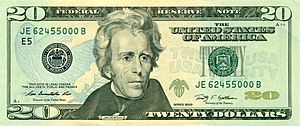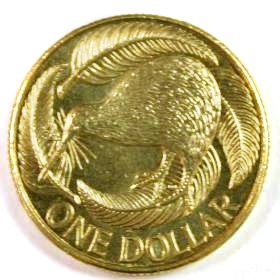Dollar facts for kids
A dollar is a type of currency, which is just another word for money. Many countries around the world use the name "dollar" for their money. Because of this, it's important to say which dollar you mean, like the "Canadian dollar" or the "Australian dollar." The symbol for the dollar is a capital letter S with one or two lines through it: $.
The word "dollar" comes from an old coin called the "thaler." This large silver coin was first made in 1518. It got its name from a mining valley in Bohemia (now part of the Czech Republic) called Joachimsthal. In German, "Thal" means valley. Later, a Spanish coin called the "Peso" was similar in size. It was often called the "Spanish dollar." In the 1700s, the Spanish dollar became very important money around the world. Many types of money we use today, like the peso, Japanese yen, Indian rupee, and Chinese Renminbi, have roots in the Spanish dollar.
Contents
How the Dollar Got Its Name
The story of the dollar starts in 1520. The Kingdom of Bohemia (a historical country in Central Europe) began making silver coins. They used silver from a local mine in a place called Joachimsthal. These coins were first called "joachimsthaler." But people soon shortened the name to "thaler" or "taler." "Joachimsthal" simply means "Joachim's valley" in German.
Over time, this name spread to many other languages. For example, it became "tolar" in Czech and "daler" in Danish and Swedish. In Dutch, it was "daalder" or "daler." From Dutch, the name eventually came into English as "dollar."
There was also a Dutch coin called the "leeuwendaler," which means "lion daler." This coin had a picture of a lion on it. The Dutch Republic made these coins for their busy international trade. The lion daler was used a lot in the Middle East and in Dutch colonies, like New Netherland Colony (which is now New York). People in the Thirteen Colonies (the first American colonies) used these coins often in the 1600s and early 1700s. They were sometimes called "lion dollars." The way we say "dollar" in American English today is still very similar to how the Dutch said "daler" long ago.
Later, Spanish coins called pesos became very common. Since they were similar in weight and shape to the thaler, they became known as "Spanish dollars." By the mid-1700s, these "Spanish dollars," also famous as "pieces of eight," were used widely. They were common in the Spanish colonies in the New World and in the Philippines.
Where the Dollar Sign Came From
The dollar sign $ first appeared in business letters in the 1770s. It was a quick way to write "ps," which stood for the Spanish American peso. This was the "Spanish dollar" in British North America. Old papers from the late 1700s and early 1800s show that the letter 's' was often written over the letter 'p'. This created a symbol very much like the '$' sign we use today. This new symbol was then used for the American dollar after the United States started using its own currency in 1785.
The United States Adopts the Dollar
By the time of the American Revolution, Spanish dollars were very important. They were used to back the paper money that individual colonies and the Continental Congress printed. Spanish dollars were so common in the Thirteen Colonies that they were even considered legal tender (official money) in Virginia.
On April 2, 1792, Alexander Hamilton, who was the first U.S. Secretary of the Treasury, told Congress how much silver was in the Spanish dollar coins. Because of this, the United States dollar was officially defined. It was set to contain a specific amount of pure silver. All smaller coins, like half-dollars and quarter-dollars, were also defined based on how much silver they contained compared to the dollar coin.
Over the years, laws changed the amount and type of metal in U.S. coins. By 1965, most silver was removed from U.S. coins. The dollar then became a fiat currency. This means its value is not based on a physical metal like gold or silver, but on trust in the government. The US Mint still makes silver dollar coins, but these are mostly for collectors, not for everyday use.
The Dollar in the United Kingdom
You might find the word "dollar" in plays by William Shakespeare. This shows that the word was used in England long ago. Coins called "thistle dollars" were used in Scotland in the 1500s and 1600s.
In 1804, a British five-shilling coin, called a crown, was sometimes called a "dollar." This was because it was a Spanish "piece of eight" coin that had been stamped over by the British. Many of these Spanish coins were captured during wars. The Bank of England reused them. They were used until 1811. During World War II, American soldiers in the UK sometimes called the half crown (a British coin worth two shillings and sixpence) a "half dollar." This was because the U.S. dollar was worth about five shillings at the time.
The Dollar Around the World
In the 1800s and early 1900s, China needed a lot of silver. Because of this, several countries, like the United Kingdom, United States, and Japan, made special "trade dollars." These coins often had slightly different weights than their own country's regular coins. Silver dollars that reached China were often stamped with Chinese characters called "chop marks." These marks showed that a trusted merchant had checked the coin and confirmed it was real.
Before 1873, the silver dollar was used in many parts of the world. Its value was linked to the British gold "sovereign." However, when Germany stopped making silver "thaler" coins in 1871, the price of silver around the world started to drop. This led the U.S. to adopt a "gold standard" in 1873. This meant the value of the U.S. dollar was tied to gold, not silver.
Because of this, the value of the dollar in North America became higher than silver dollars used in other places, like Latin America and the Far East. By 1900, silver dollars were worth only half as much as gold dollars. Over time, different dollar currencies started to have different values. For example, the Canadian dollar began to have a different value than the U.S. dollar after 1931.
Many other countries have also chosen the name "dollar" for their money. They often did this when they changed their money system to a decimal system (like ours, based on 100 cents). Some examples include the Australian dollar, New Zealand dollar, Jamaican dollar, Fiji dollar, and Namibian dollar.
- The tala is the Samoan way of saying "dollar."
- The Slovenian tolar also has the same origin as the word "dollar" (from "thaler").
List of dollars
- Australian dollar
- Bahamian dollar
- Barbadian dollar
- Belize dollar
- Canadian dollar
- East Caribbean dollar
- New Zealand Dollar
- Singapore dollar
- United States dollar
Images for kids
-
One Sarawak dollar from 1935, featuring Charles Vyner Brooke, the 3rd and last White Rajah of Sarawak.
See also
 In Spanish: Dólar para niños
In Spanish: Dólar para niños






